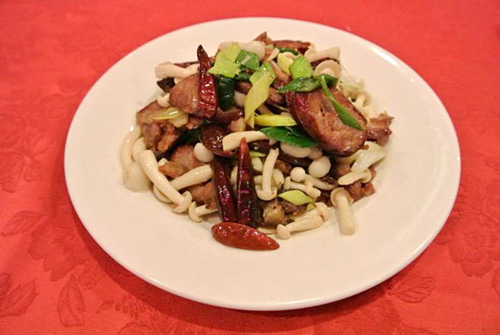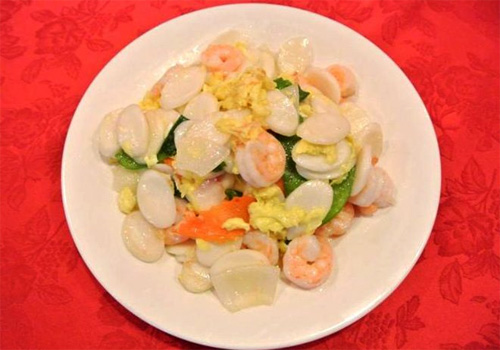Meet the Monkey
Sound to Nuts Review | NJ Monthly
By Suzanne Zimmer Lowery | February 1, 2016
The Chinese Year of the Monkey, that is. Explore its culinary traditions at Cheng Du 23, Kevin Lin’s highly regarded Szechuan restaurant in Wayne.
[View online or PDF]Szechuan rice cakes with shrimp at Cheng Du 23 in Wayne.
On the Chinese lunar calendar, the Year of the Monkey begins February 8th, and Kevin Lin, owner of Cheng Du 23 in Wayne, is presenting eight traditional dishes to kick off the festivities.
The 12-year Chinese zodiac, in which each year in the cycle is symbolized by a different animal, can fall from late January to mid-February. It’s a time of thanksgiving and celebration.
One of the most traditional dishes Lin serves is Szechuan sausage with pearl mushroom, leeks and green garlic. “Sausage,” he says, “is prepared and enjoyed in virtually every Chinese home at this time of year.”
Nian gao rice cakes with shrimp at Cheng Du 23 in Wayne
Szechuan sausage with pearl mushrooms, leeks and green garlic at Cheng Du 23 in Wayne.

Another New Year tradition is cooking with rice cakes, called nian gao in Mandarin. Nian gao, Lin says, translates as “’year high,’ because every year you want to reach higher and higher.” At Cheng Du 23, rice cakes are served at this time of year with shrimp and egg.
Rice cakes resurface in ball form in a New Year dessert soup in a broth made with osmanthus flowers, sesame and wine.

Whole fried sea bass–the head and tail intact to symbolize both a good start and good finish to the year–is served in a sauce of ground pork and pickled chilies. Lin calls it “the most important dish of New Year’s Day.
“In Chinese, the word yu, meaning fish, sounds like yue,” Lin explains, and yue represents abundance, particularly in money and savings.
It is important to use a firm-fleshed fish like sea bass, which will not break apart when fried, Lin says, because the dish is meant to signify family togetherness. It is often served on New Year’s Eve. A very large specimen is prized, because it promises leftovers, symbolically carrying good fortune into the first day of the year.
A New Year’s ritual is giving shiny red envelopes filled with money. Lin’s two young sons will receive coins in their envelopes. His employees, he says, will receive much more substantial envelopes in a parallel to the American year-end bonus.
Lin, 37, emigrated to San Francisco 17 years ago to work in his uncle’s restaurant. Eventually, he made his way to New York, where he continued to learn the business before opening Cheng Du 23 in 2008. Lin formerly owned Shanghai 46 on Route 46 in Fairfield, a restaurant specializing in the mild seafood cuisine of Shanghai.
Nian Gao Rice Cakes With Shrimp
Serves 2
Ingredients:
1 pound rice cake (found frozen and pre-sliced in Chinese and Korean markets), thawed and softened (see below)
2 eggs, scrambled
8 ounces small/medium shrimp, peeled/ can use fresh or thawed pre-cooked shrimp
1/2 red onion, sliced thin
1/2 cup carrot, sliced thin or in matchsticks
2 cups snow peas
2 tablespoons vegetable oil
1 clove garlic, minced
1 teaspoon fresh ginger, minced
1 teaspoon Chinese rice wine or dry sherry
salt to taste
1 teaspoon dark sesame oil
Pinch sugar
1/4 cup (or less) chicken broth
freshly ground black pepper
sliced scallions for garnish
Directions:
Bring a pot of water to a boil. Add the rice cakes and boil for 1-2 minutes to soften. Strain and set aside.
Heat a wok or large sauté pan, and add the oil to coat. When near-smoking, add the shrimp and rice cakes and stir fry for 1 minute. Add the garlic and ginger, tossing continually to prevent burning.
Add the shrimp, onion, carrots and snow peas. Stir fry on high heat for about a minute, and add the wine.
Add salt, sesame oil and sugar one by one, continually stirring to integrate ingredients. Add chicken broth, as much as needed to make a light sauce.
When shrimp is cooked through, remove from heat; add additional salt/pepper to taste. Serve topped with sliced scallions.


